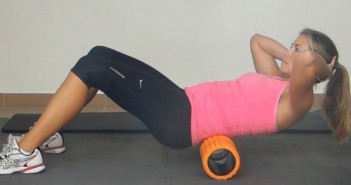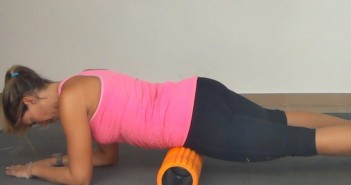The Foam Roller Chest Exercise is a great self-massage exercise that will give your chest muscles a deep and effective sports massage, thus improving the health and quality of your muscle tissue and helping you to perform better. It will also alleviate soreness and make your muscles feel better.
The foam roller overloads the muscle tissues through compression, causing your nerves to relax, signalling muscle spasms to shut off, pumping blood and and getting your lymphatic system flowing, to help muscle recovery and regeneration. You’ll work out those knots (muscle adhesions) in your muscles caused either by inactivity, by the repetitive strain of the golf swing, or by walking a tough golf course. This will enable you to stretch the muscles back out to their original length, making them more pliable and functional.
The Foam Roller Chest Exercise can be performed both before and after playing golf, practising on the range, or other physical activity. It’s also great after sitting in the same position for a while, and can be enjoyed anywhere and anytime you feel tight and in need of a massage, such as while watching television or before bedtime.
Equipment
This exercise requires a foam roller, also referred to as a foam roll.
For more information on the foam roller and its benefits, see An Introduction to the Foam Roller – The Golfer’s Best Friend.
Steps
- Lie facedown with a foam roller under one armpit and that arm extended.
- Roll under the arm and over your upper chest, placing as much weight on the foam roller as you can tolerate.
- Repeat with the roller under the other armpit.
Work the foam roller back and forth, gliding your upper chest over the foam roller, for 30 to 60 seconds on each side. As you work you’ll discover muscle spasms and tender pressure points, hold on each pressure point for an additional 30 seconds until the muscle releases from spasm.
The first time you perform this exercise, it might be a little painful, just like a professional sports massage would be, but that’s just a sign that you stand to benefit enormously from it. After the first few sessions, it will start to become considerably easier and more comfortable. The better it feels, and the less it hurts, the better the quality of your muscle tissue.
Only go as deep as you can tolerate, and slowly build up the amount of time you spend on this exercise.
Target Muscles
This exercise mainly involves your pectoralis major and pectoralis minor muscles.
How Will It Benefit Your Golf Swing?
The muscles of your chest are placed under a lot of repetitive strain during a round of golf or a practice session. For optimal golf swing performance, you need to maintain the quality, mobility and efficiency of these muscle tissues.
Most shots in golf don’t require much upper body strength and power, but when playing out of thick rough you need to drive the club head through the thick grass. The pectorals help to generate the club head momentum required to do this. At times like this, strong chest muscles become extremely important for your shot-making potential. They enable you to drive through the rough without losing too much club head speed or club stability, while still creating enough ball compression to get some spin on the ball. If your chest muscles are strong and working efficiently, you will be able to get back to the fairway much more easily, and you will also have more opportunities to go for the green from a difficult lie.
For details of how the chest muscles, specifically the pectorals, should work in the golf swing, see The Role of the Right Arm in the Golf Downswing.
If you have any questions or comments about this or other articles on Golf Loopy, please send us an email.
You May Also Like…
Golf Performance Programmes – the most effective golf-specific fitness regimens on the planet, guaranteed to make you a better golfer!
There are a number of other golf recovery and regeneration exercises in the Golf Loopy Train like a Champion System.
An Introduction to the Foam Roller – The Golfer’s Best Friend.
Introduction to the Swing like a Champion System.
Golf Anatomy and Kinesiology, a collection of articles describing the roles of the muscles involved in the golf swing.



